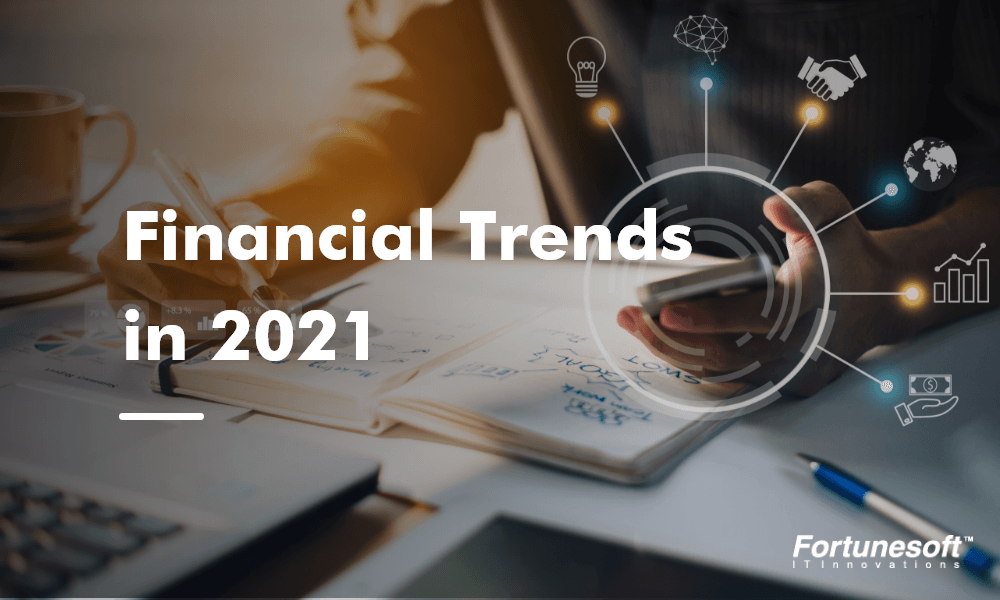 By Sheelu George October 13, 2020
11 min read
By Sheelu George October 13, 2020
11 min read8 Ways to power up your fintech product using AI
Today, fintech is empowering businesses globally. With their wide range of new and innovation-driven financial services and products, they have paved an effective way to manage your finances.
The more the technology is advancing, the consumers are becoming smart and demanding. They have today shifted to mobile devices for performing financial transactions.
Technologies like AI, ML, NLP, Blockchain are contributing to making the systems automated, fast, secure, and scalable and therefore, booming the fintech market. A study by Mordor Intelligence shows that AI in the fintech market is estimated to contribute USD 35.40 billion by 2025.
Let’s explore how the capability of AI to act like humans will help the fintech domain to rise and set a benchmark in the financial ecosystem.
1. Digital Financial Advisor
Digital financial advisors or transactional bots or Robo-advisors are the trending applications of AI providing financial planning services with little or no human supervision. These Robo-advisors are digital platforms that provide algorithm-based financial services.
Robo-advisors are capable of handling complex tasks like tax-loss harvesting, investment selection, and retirement planning in addition to spending and saving plans. To use Robo-advisor services, the customer is required to log into the application and go through a short survey that is basically a questionnaire regarding their future goals and financial situations. Once the entire data is received, the application software utilizes the data to analyze the customer’s current financial situation.
Some of the software is capable of recommending necessary steps for the user to manage their wealth and correctly invest it. Some digital financial advisors track the customer’s spending based on account activity and advice suggestions depending on the budget.
2. Fraud Detection & Prevention
Digital payments have to deal with two kinds of fraud :
1. Fraud by the merchants while collecting payments.
2. Fraud by parties that steal the credentials or cards.
Let’s check out how AI technology is incorporated in the FinTech scenario for fraud detection.
To detect fraud merchants, it is essential to scrutinize their KYC and their online and offline track. With AI, the authenticity of the KYC documents is automatically verified by using pattern matching algorithms and computer vision. Also, AI helps in identifying negative patterns on the merchant’s online track, including social media- which is one of the powerful mediums to detect suspicious merchants.
Machine Learning has gained a lot of limelight in the fintech domain for its capability to fight fraud in real-time using historical data. AI algorithms match those historical data with the current transactions. The AI algorithms are capable of taking hundreds of variables like amount, device, location, etc., related to a transaction, to determine the probability of fraud transaction. This will help the parties to take preventive actions in real-time to prevent fraud.
3. Automated Trading
Algo trading or automated trading is a set of instructions to place a trade by analyzing data and fast decision-making capabilities through Machine Learning. Machine Learning based automated trading generates profits at high speed and frequency as compared to the human trader.
ML models’ only requirement is to have a massive amount of data for training models. These data can be the present information or historical data. Precision is at it’s best when ML models have more data. The most advanced case of AI in fintech is pattern detection by algorithms of these data much faster than their human counterparts. Today, most of the investment companies are trying to invest in algorithmic trading for making portfolio suggestions to meet individual investors’ demand.
4. Claim Processing
Undoubtedly, claim processing is one of the most complex tasks that insurance companies have to go through. The complexity of the task is due to the long and tedious process that involves identifying customer claims like accidents, sickness, verifying the cases whether they are genuine or not, activation process, and many more.
AI can be used to identify fraudulent claims accurately and also reduce the time required to settle the claim. This can be done by developing a fraud detection platform that will automate the fraudulent claim identification.
Distributed ledger technology can be used to speed up the claim process with reduced costs, especially for claims that go through the subrogation process.
AI-powered chatbots can be used to automate the query management process, support the insurance agents for carrying out the processes faster, streamlining the underwriting process, automating claim processing and eliminating repetitive tasks, seamless handling of live-agents, etc.
The insurance companies are heavily driven by consumerization and technology which results in heavy investments in consumer-centric platforms and AI is the best choice to get your desired insuretech product done.
5. Client Risk Profiling
In finance, risk profiling depends on three factors: risk tolerance, risk required, and risk capacity.Risk tolerance is all about your customer’s emotional ability to take a financial risk. You have to analyze their capacity to tolerate investment ups and downs, bigger returns, and so on. The risk required is calculating the risks associated with the returns from available financial resources to achieve your client’s goals.Risk capacity is how much your client can take the risk.
Risk profiling is all about calculating the client’s investment risk score associated with his profile by balancing risk capacity, risk required, and his emotional ability for risk tolerance.AI has a major role to play when it comes to risk profiling. Artificial Neural Network (ANN) can be used to rate the client profile from low to high on the basis of historical or pre-labeled data. Machine learning can be used for identifying key variables, loan balances to avoid frauds, customer behavior, performance analysis, customer segmentation, and many customer patterns that are helpful to calculate the risk associated with the client’s profile.
AI has the capacity to generate innovative solutions to address complex problems in client risk profiling.
6. Voice-first search and payments
Now simplify your everyday banking operations with a voice command. Whether account balance, transfers, credits, or bill payments, voice technology provides an optimal experience through personalization.
Voice payments are aiming to become mainstream in the financial ecosystem after developing robust secured systems, as security is always a concern. Some of the leading financial giants are using voice biometric to identify clients.
The adoption of voice payments is forecasted to be 77.9 million users by 2022. With such a whopping stats, it is clear that voice banking will be a showstopper in 2021 and beyond.
7. Facial recognition
According to a report by Global Market Insights, the market size of facial recognition is forecasted to cross US$12 billion between 2020 and 2026 with a compound annual growth rate of over 18%.
MasterCard has used the capability of facial recognition to authenticate payments through a selfie using the phone camera. HSBC, Chase, and other international banks are using facial recognition to allow users to securely login to their mobile banking apps. LG CNS has provided payment automation for employees using facial recognition and cloud servers.
Another upcoming advancement in facial recognition by Seven Bank is to create accounts on the spot in ATMs using facial recognition. Facial recognition can be used for authenticating banking transactions, verifying customers’ identities, and digital onboarding proving it to be a trend for 2021 and beyond.
8. Predictive Analysis
Whether customer experience or providing solutions to the users on the basis of their financial goals, predictive analysis can be your game-changer in the upcoming year.
Predictive analysis helps to improve customer experience by providing a personalized experience through automation. Chatbots and Robo advisors are turning out to be very effective by use of predictive analysis and automation wherein they assist their customers with specific products and requirements.
Intelligent finance is another way where predictive analysis is used. To provide a promising service and guidance to your customers about managing the finances requires various patterns like expenditure, savings, and many more. Predictive analysis is used to identify these patterns and provide solutions for future financial needs on the basis of these patterns.
Other applications of predictive analysis are customer insights, automating the ATM machine downtime, operational performance, and resource utilization.
Predictive analysis is an important part of fintech, and therefore, becomes necessary to incorporate and leverage its benefits in the upcoming years.
In a nutshell
AI is a major disruption in the fintech industry and this is proved by the top 5 ways listed above. To know more about how AI can penetrate into your fintech organization and enhance efficiency with reduced costs, automate workflows and streamline processes, consult a fintech development company that will guide you for your financial queries.
Author Bio


 Facebook
Facebook Whatsapp
Whatsapp LinkedIn
LinkedIn Pinterest
Pinterest














 Start Chat
Start Chat